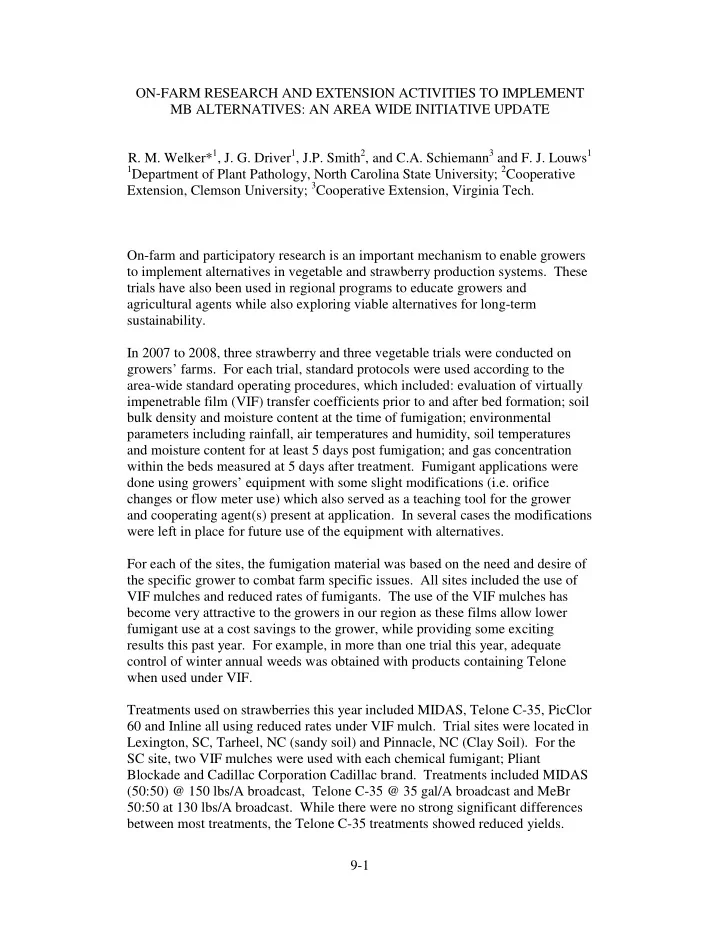

ON-FARM RESEARCH AND EXTENSION ACTIVITIES TO IMPLEMENT MB ALTERNATIVES: AN AREA WIDE INITIATIVE UPDATE R. M. Welker* 1 , J. G. Driver 1 , J.P. Smith 2 , and C.A. Schiemann 3 and F. J. Louws 1 1 Department of Plant Pathology, North Carolina State University; 2 Cooperative Extension, Clemson University; 3 Cooperative Extension, Virginia Tech. On-farm and participatory research is an important mechanism to enable growers to implement alternatives in vegetable and strawberry production systems. These trials have also been used in regional programs to educate growers and agricultural agents while also exploring viable alternatives for long-term sustainability. In 2007 to 2008, three strawberry and three vegetable trials were conducted on growers’ farms. For each trial, standard protocols were used according to the area-wide standard operating procedures, which included: evaluation of virtually impenetrable film (VIF) transfer coefficients prior to and after bed formation; soil bulk density and moisture content at the time of fumigation; environmental parameters including rainfall, air temperatures and humidity, soil temperatures and moisture content for at least 5 days post fumigation; and gas concentration within the beds measured at 5 days after treatment. Fumigant applications were done using growers’ equipment with some slight modifications (i.e. orifice changes or flow meter use) which also served as a teaching tool for the grower and cooperating agent(s) present at application. In several cases the modifications were left in place for future use of the equipment with alternatives. For each of the sites, the fumigation material was based on the need and desire of the specific grower to combat farm specific issues. All sites included the use of VIF mulches and reduced rates of fumigants. The use of the VIF mulches has become very attractive to the growers in our region as these films allow lower fumigant use at a cost savings to the grower, while providing some exciting results this past year. For example, in more than one trial this year, adequate control of winter annual weeds was obtained with products containing Telone when used under VIF. Treatments used on strawberries this year included MIDAS, Telone C-35, PicClor 60 and Inline all using reduced rates under VIF mulch. Trial sites were located in Lexington, SC, Tarheel, NC (sandy soil) and Pinnacle, NC (Clay Soil). For the SC site, two VIF mulches were used with each chemical fumigant; Pliant Blockade and Cadillac Corporation Cadillac brand. Treatments included MIDAS (50:50) @ 150 lbs/A broadcast, Telone C-35 @ 35 gal/A broadcast and MeBr 50:50 at 130 lbs/A broadcast. While there were no strong significant differences between most treatments, the Telone C-35 treatments showed reduced yields. 9-1
This is believed to be from some slight stunting of the plants which might have been caused by the application rate. While the amount used was reduced over the normal rate used at this site, the 35 gal/A broadcast rate used seems to have been too high for use under VIF. Plant growth parameters were all similar for the fumigant treatments, and the yield data showed slight differences as seen in Figure 1: SC Strawberry Yield - Pounds / Acre 28000 26000 24000 22000 20000 18000 16000 14000 12000 10000 Telone C-35/Blocade Telone C-35/Cadillac Midas/Cadillac Midas/Blocade Methyl Bromide Untreated Figure 1: Final yield for SC strawberries. Lines above treatments indicate statistical similarities (0.05 level). For both North Carolina studies, there were no significant differences in yield data for any of the fumigant treatments, and all plant growth parameters measured were similar with the exception of non fumigated treatments. Fumigant treatments included PicClor 60 @ 188 lbs/A broadcast, Telone C-35 @ 294 lbs/A broadcast, Inline @ 13 gal/A broadcast and methyl bromide (50:50) @ 250 lbs /A broadcast. One exciting outcome was weed data from the Tar Heel, NC site where weed data showed a drastic reduction in winter annual weeds with both the PicClor 60 and Inline treatments under VIF. Both treatments include Telone and chloropicrin which have not provided adequate weed control in past studies under standard plastic. The results of weed counts are shown in Figure 2: 9-2
Eastern NC Total Weeds 60 50 40 Percent 30 20 10 0 untreated inline PicClor 60 Methyl Bromide Table 2: Percent of plant holes containing winter annuals during the growing season. An important part of each trial was the on-farm field day which was help just prior to harvest initiation at each site. These field days were coordinated by the cooperative extension agents in each area and attracted growers, other cooperative extension agents and regional agronomists to each site. Nearly 100 people total attended the on-farm demonstrations and all were given information about currently available alternatives, equipment modifications and calibration and were shown the crop growth with the alternative treatments. In addition to the strawberry work, two North Carolina tomato trials and one South Carolina pepper trial were started in 2008 on growers farms. Treatments included MIDAS, Paladin, Inline, PicClor 60 and Telone C-35, all using reduced rates in conjunction with VIF mulch. Treatments were again made in cooperation with growers and local cooperative extension personnel in the same manner as described for the strawberry trials. We are currently still gathering data from these trials and are in the planning stages for several on-farm field days. As with the strawberry trials, all the fumigant treatments in the vegetables look good. Additional results will be presented at the conference in Orlando. 9-3
Recommend
More recommend